Abstract
In unambiguous state discrimination, the measurement results consist of the error-free results and an inconclusive result, and an inconclusive result is conventionally regarded as a useless remainder from which no information about initial states is extracted. In this paper, we investigate the problem of extracting remaining information from an inconclusive result, provided that the optimal total success probability is determined. We present three simple examples. An inconclusive answer in the first two examples can be extracted partial information, while an inconclusive answer in the third one cannot be. The initial states in the third example are defined as the highly symmetric states.
Similar content being viewed by others
References
Gisin, N., Ribordy, G., Tittel, W., et al.: Quantum cryptography. Rev. Mod. Phys. 74, 145 (2002)
Barnett, S.M., Croke, S.: Quantum state discrimination. Adv. Opt. Photon. 1, 238 (2009)
Bergou, J.A.: Discrimination of quantum states. J. Mod. Opt. 57, 160 (2010)
Ivanovic, I.D.: How to differentiate between non-orthogonal states. Phys. Lett. A 123, 257 (1987)
Dieks, D.: Overlap and distinguishability of quantum states. Phys. Lett. A 126, 303 (1988)
Peres, A.: How to differentiate between non-orthogonal states. Phys. Lett. A 128, 19 (1988)
Jaeger, G., Shimony, A.: Optimal distinction between two non-orthogonal quantum states. Phys. Lett. A 197, 83 (1995)
Peres, A., Terno, D.R.: Optimal distinction between non-orthogonal quantum states. J. Phys. A 31, 7105 (1998)
Chefles, A.: Unambiguous discrimination between linearly-independent quantum states. Phys. Lett. A 238, 339 (1998)
Sun, Y., Hillery, M., Bergou, J.A.: Optimum unambiguous discrimination between linearly independent nonorthogonal quantum states and its optical realization. Phys. Rev. A 64, 022311 (2001)
Jafarizadeh, M.A., Rezaei, M., Karimi, N., et al.: Optimal unambiguous discrimination of quantum states. Phys. Rev. A 77, 042314 (2008)
Samsonov, B.F.: Optimal positive-operator-valued measures for unambiguous state discrimination. Phys. Rev. A 79, 042312 (2009)
Pang, S., Wu, S.: Optimum unambiguous discrimination of linearly independent pure states. Phys. Rev. A 80, 052320 (2009)
Bergou, J.A., Futschik, U., Feldman, E.: Optimal unambiguous discrimination of pure quantum states. Phys. Rev. Lett. 108, 250502 (2012)
Nakahira, K., Usuda, T.S., Kato, K.: Discrimination between geometrically uniform quantum states with inconclusive results. Phys. Rev. A 86, 032316 (2012)
Rudolph, T., Spekkens, R.W., Turner, P.S.: Unambiguous discrimination of mixed states. Phys. Rev. A 68, 010301(R) (2003)
Herzog, U., Bergou, J.A.: Optimum unambiguous discrimination of two mixed quantum states. Phys. Rev. A 71, 050301(R) (2005)
Herzog, U.: Optimum unambiguous discrimination of two mixed states and application to a class of similar states. Phys. Rev. A 75, 052309 (2007)
Zhou, X.F., Zhang, Y.S., Guo, G.C.: Unambiguous discrimination of mixed states: a description based on system-ancilla coupling. Phys. Rev. A 75, 052314 (2007)
Kleinmann, M., Kampermann, H., Bruß, D.: Unambiguous state discrimination: optimal solution and case study. Phys. Rev. A 81, 020304(R) (2010)
Helstrom, C.W.: Quantum Detection and Estimation Theory. Academic Press, New York (1976)
Barnett, S.M.: Minimum-error discrimination between multiply symmetric states. Phys. Rev. A 64, 030303(R) (2001)
Herzog, U., Bergou, J.A.: Minimum-error discrimination between subsets of linearly dependent quantum states. Phys. Rev. A 65, 050305(R) (2002)
Chou, C.L.: Minimum-error discrimination among mirror-symmetric mixed quantum states. Phys. Rev. A 70, 062316 (2004)
Mochon, C.: Family of generalized “pretty good” measurements and the minimal-error pure-state discrimination problems for which they are optimal. Phys. Rev. A 73, 032328 (2006)
Qiu, D.: Minimum-error discrimination between mixed quantum states. Phys. Rev. A 77, 012328 (2008)
Tyson, J.: Error rates of Belavkin weighted quantum measurements and a converse to Holevo’s asymptotic optimality theorem. Phys. Rev. A 79, 032343 (2009)
Bae, J., Hwang, W.Y.: Optimal discrimination of Qubit States—methods, solutions, and properties. Phys. Rev. A 87, 012334 (2013)
Croke, S., Andersson, E., Barnett, S.M., et al.: Maximum confidence quantum measurements. Phys. Rev. Lett. 96, 070401 (2006)
Mosley, P.J., Croke, S., Walmsley, I.A., et al.: Experimental realization of maximum confidence state discrimination for the extraction of quantum information. Phys. Rev. Lett. 97, 193601 (2006)
Herzog, U.: Discrimination of two mixed quantum states with maximum confidence and minimum probability of inconclusive results. Phys. Rev. A 79, 032323 (2009)
Steudle, G.A., Knauer, S., Herzog, U., et al.: Experimental optimum maximum-confidence discrimination and optimum unambiguous discrimination of two mixed single-photon states. Phys. Rev. A 83, 050304 (2011)
Jiménez, O., Solís-Prosser, M.A., Delgado, A., et al.: Maximum-confidence discrimination among symmetric qudit states. Phys. Rev. A 84, 062315 (2011)
Sedlák, M.: Quantum theory of unambiguous measurements. Acta Physica Slovaca 56(6), 653 (2009)
Chefles, A., Barnett, S.M.: Strategies for discriminating between non-orthogonal quantum states. J. Mod. Opt. 45, 1295 (1998)
Herzog, U.: Optimal state discrimination with a fixed rate of inconclusive results: Analytical solutions and relation to state discrimination with a fixed error rate. Phys. Rev. A 86, 032314 (2012)
Bagan, E., Muñoz-Tapia, R., Olivares-Rentería, G.A., et al.: Optimal discrimination of quantum states with a fixed rate of inconclusive outcomes. Phys. Rev. A 86, 040303(R) (2012)
Jiménez, O., Bergou, J., Delgado, A.: Probabilistic cloning of three symmetric states. Phys. Rev. A 82, 062307 (2010)
Acknowledgments
This work was funded by the National Science Foundation of China under Grant No. 61073048, and 11104057, the Natural Science Foundation of the Education Department of Anhui Province of China under Grant No. KJ2012A245, and Anhui Provincial Natural Science Foundation under Grant No. 1408085MA20.
Author information
Authors and Affiliations
Corresponding author
Appendix: Derivation of three linearly independent symmetric states
Appendix: Derivation of three linearly independent symmetric states
The input states we explore are given in Ref. [38]. The authors defined the symmetric states
where the arbitrary \(c_k \) coefficients satisfy the normalization condition \(\sum _{i=1}^3 {\left| {c_i } \right| ^{2}} =1\). The complex inner product \(S=\left| S \right| e^{i\theta }\) among the symmetric states is defined by
The symmetric states are linearly independent if and only if \(S\in \left[ {0,\left| {S_\theta } \right| } \right) \) [38], where
Note that \(S=0\) implies the states are orthogonal and \(S=\left| {S_\theta } \right| \) implies three linearly dependent states. In our paper, we take \(S\in \left( {0,\left| {S_\theta } \right| } \right) \), implying three linearly independent symmetric states. We use the second expression in Eq. (43). For \(\beta \in \left( {0,\pi /4} \right) \), we define the phase factor, \(\theta \), as
So the second expression turns to
When \(S=\left| {S_\theta } \right| \), the symmetric states become linearly dependent. For example, the linearly dependent symmetric states are given by Eq. (59) [29]
with the complex inner product
Rights and permissions
About this article
Cite this article
Zhang, G., Yu, LB., Zhang, WH. et al. Extracting remaining information from an inconclusive result in optimal unambiguous state discrimination. Quantum Inf Process 13, 2619–2632 (2014). https://doi.org/10.1007/s11128-014-0817-8
Received:
Accepted:
Published:
Issue Date:
DOI: https://doi.org/10.1007/s11128-014-0817-8




